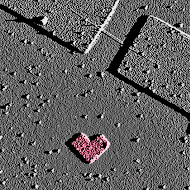how to clean graphene?
Graphene is a single layer of carbon atoms. However the problem is that many things like to stick to graphene (polymers, glue from scotch tape, thermal tape, amorphous carbon and all the other kind of 'dirt'). This can be quite dramatic, especially when you realize that sometimes thickness of the dirt accumulated is bigger that the thickness of graphene itself! In that case you have to think, what are you actually measuring? Is it really graphene or graphene + contamination?To clean graphene a few methods were invented
1. Thermal annealing - annealing in an oven, in high temperature (around 300-350C) and Ar/H2 ambient. All the organic contamination is removed.
2. Current annealing - passing high current through graphene in vacuum. Due to high temperature some of the contamination evaporates and some is moved to the electrodes due to electromigration.
3. Mechanical cleaning - with AFM tip in contact mode. The tip sweeps graphene surface mechanically removing the contamination.
4. Cleaning with carbon nanotubes - recently I realized that I can use CNTs to sweep the dirt away from the graphene. If you pass a nanotube on top of graphene surface, it will become very clean and you can easily see it with AFM image. In a way it is similar to AFM contact mode, but it´s much faster: you can sweep 1x1 um in a few seconds.
Below an image of nanotube (MWNT) cleaning graphene:






4 comments:
hey! that´s great!!! i think you should write a small paper about this!!
thanks for share this!!!
thanks!!
Hello dear, it is also another option, to put your sample on a high frequency bath for 2 - 5 min. After that, you might have a not too bad surface ... I did enjoy to read your post and agree with Amelia ... looking forward to reading it :P
Post a Comment